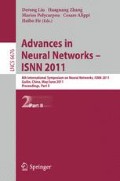Abstract
Biological evolution endows human vision perception with an “optimal” or “near optimal” structure while facing a large variety of visual stimuli in different environment. Mathematical principles behind the sophisticated neural computing network facilitate these circuits to accomplish computing tasks sufficiently as well as at a relatively low energy consumption level. In other words, human visual pathway, from retina to visual cortex has met the requirement of “No More Than Needed” (NMTN). Therefore, properties of this “nature product” might cast a light on the machine vision. In this work, we propose a biological inspired computational vision model which represents one of the fundamental visual information — orientation. We also analyze the efficiency trade-off of this model.
Access this chapter
Tax calculation will be finalised at checkout
Purchases are for personal use only
Preview
Unable to display preview. Download preview PDF.
References
Kolb, H.: How the Retina Works. American Scienctist 91, 28–35 (2003)
Lee, B.B.: Receptive Field Structure in the Primate Retina. Vision Res. 36, 631–644 (1996)
Hubel, D.H., Wiesel, T.N.: Receptive Fields, Binocular interaction and functional architecutre in the cat’s visual cortex. J. Physiology 160, 106–154 (1962)
Zhan, X., Shou, T.: Anatomical Evidence of Subcortical Contributions to the Orientation Selectivity and Columns of the Cat’s Primary Visual Cortex. Neurosci. Lett. 324, 247–251 (2002)
Rodieck, R.W.: Quantitative analysis of cat retinal ganglion cell response to visual stimuli. J. Vision Res. 5, 583–601 (1965)
Kier, C.K., Buchsbaum, G., Sterling, P.: How retinal microcircuits scale for ganglion cells of different size. J. Neurosci. 15 (1995)
Croner, L.J., Kaplan, E.: Receptive Fields of P and M Ganglion Cells Across the Primate Retina. Vision Res. 35, 7–24 (1995)
Wei, H., Jiang, Y.: An Orientational Sensitive Vision Model Based on Biological Retina. In: 2nd International Conference on Cognitive Neurodynamics (2009)
Distinctive Image Features from Scale-invarient Keypoints. Internatinoal Journal of Computer Vision (2004)
Bay, H., Tuytelaars, T., Van Gool, L.: SURF: Speeded Up Robust Features. In: Leonardis, A., Bischof, H., Pinz, A. (eds.) ECCV 2006. LNCS, vol. 3951, pp. 404–417. Springer, Heidelberg (2006)
Dalal, N., Triggs, B.: Histograms of Oriented Gradiants for Human Detection. In: Computer Vision and Pattern Recognition (2005)
Wallace, R.S., Ong, P.W., Bederson, B.B., Schwartz, E.L.: Space-Variant Image-Processing. International Journal of Computer Vision 13, 71–90 (2004)
Shah, S., Levine, M.D.: Visual Information Processing in Primate Cone Pathways — Part I: A Model. IEEE Transaction on Systems, Man and Cybernetics, Part B 26, 259–274 (1996)
Balasuriya, S., Siebert, P.: A Biologically Inspired Computational Vision Front-end based on a Self-Organised Pseudo-Randomly Tessellated Artificial Retina. In: International Joint Conference on Neural Networks (2005)
Author information
Authors and Affiliations
Editor information
Editors and Affiliations
Rights and permissions
Copyright information
© 2011 Springer-Verlag Berlin Heidelberg
About this paper
Cite this paper
Jiang, Y., Wei, H. (2011). Orientation Representation and Efficiency Trade-off of a Biological Inspired Computational Vision Model. In: Liu, D., Zhang, H., Polycarpou, M., Alippi, C., He, H. (eds) Advances in Neural Networks – ISNN 2011. ISNN 2011. Lecture Notes in Computer Science, vol 6676. Springer, Berlin, Heidelberg. https://doi.org/10.1007/978-3-642-21090-7_26
Download citation
DOI: https://doi.org/10.1007/978-3-642-21090-7_26
Publisher Name: Springer, Berlin, Heidelberg
Print ISBN: 978-3-642-21089-1
Online ISBN: 978-3-642-21090-7
eBook Packages: Computer ScienceComputer Science (R0)

